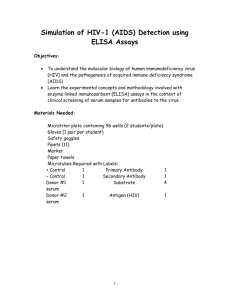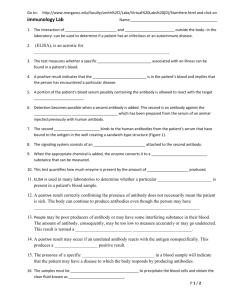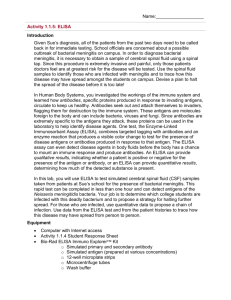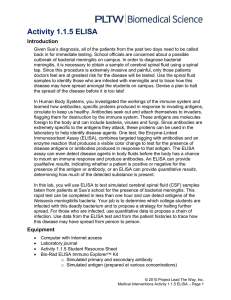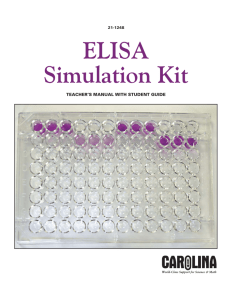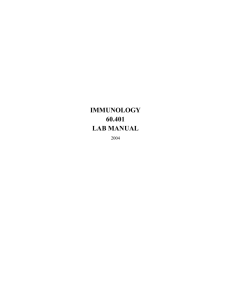ELISA Long - Juniata College
advertisement
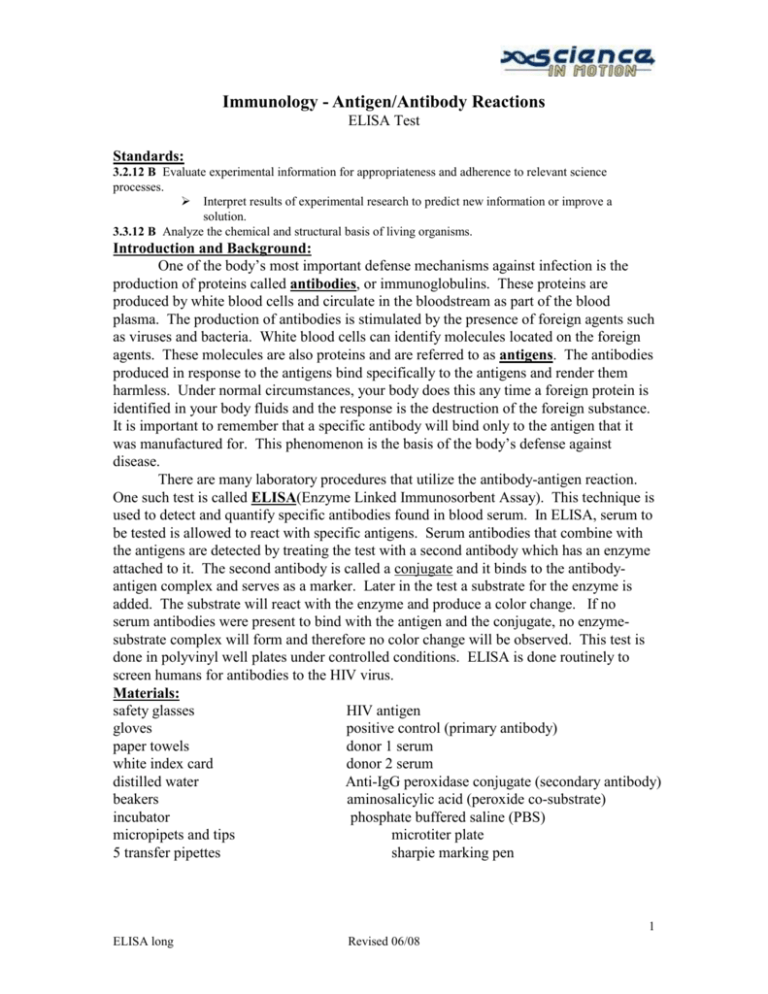
Immunology - Antigen/Antibody Reactions ELISA Test Standards: 3.2.12 B Evaluate experimental information for appropriateness and adherence to relevant science processes. Interpret results of experimental research to predict new information or improve a solution. 3.3.12 B Analyze the chemical and structural basis of living organisms. Introduction and Background: One of the body’s most important defense mechanisms against infection is the production of proteins called antibodies, or immunoglobulins. These proteins are produced by white blood cells and circulate in the bloodstream as part of the blood plasma. The production of antibodies is stimulated by the presence of foreign agents such as viruses and bacteria. White blood cells can identify molecules located on the foreign agents. These molecules are also proteins and are referred to as antigens. The antibodies produced in response to the antigens bind specifically to the antigens and render them harmless. Under normal circumstances, your body does this any time a foreign protein is identified in your body fluids and the response is the destruction of the foreign substance. It is important to remember that a specific antibody will bind only to the antigen that it was manufactured for. This phenomenon is the basis of the body’s defense against disease. There are many laboratory procedures that utilize the antibody-antigen reaction. One such test is called ELISA(Enzyme Linked Immunosorbent Assay). This technique is used to detect and quantify specific antibodies found in blood serum. In ELISA, serum to be tested is allowed to react with specific antigens. Serum antibodies that combine with the antigens are detected by treating the test with a second antibody which has an enzyme attached to it. The second antibody is called a conjugate and it binds to the antibodyantigen complex and serves as a marker. Later in the test a substrate for the enzyme is added. The substrate will react with the enzyme and produce a color change. If no serum antibodies were present to bind with the antigen and the conjugate, no enzymesubstrate complex will form and therefore no color change will be observed. This test is done in polyvinyl well plates under controlled conditions. ELISA is done routinely to screen humans for antibodies to the HIV virus. Materials: safety glasses HIV antigen gloves positive control (primary antibody) paper towels donor 1 serum white index card donor 2 serum distilled water Anti-IgG peroxidase conjugate (secondary antibody) beakers aminosalicylic acid (peroxide co-substrate) incubator phosphate buffered saline (PBS) micropipets and tips microtiter plate 5 transfer pipettes sharpie marking pen 1 ELISA long Revised 06/08 Science In Motion Juniata College Safety Notes: 1. The chemicals you will be working with are irritants, and some cause allergic reactions. Avoid eye/skin contact and do not ingest. Flush spills with water for 15 minutes. Notify your instructor. 2. Wear safety glasses and gloves at all times. 3. Wash your hands thoroughly at the end of each lab session. Procedure: 1. Label the microtiter plate with your initials and number the rows down the side. 2. Label the transfer pipettes 1, 2, 3, 4, PBS. 3. Add 100 microliters of HIV antigen to each well. Let stand at room temperature for 5 minutes. 4. Using a transfer pipette remove all liquid from the wells. 5. Wash all wells by adding approximately 200 microliters of phosphate buffered saline (PBS). DO NOT OVERFLOW THE WELLS! Label a transfer pipette for each row. Using the appropriate pipette, remove all liquid from the wells and discard in the beaker. 6. To each well in row 1, add 100 microliters of PBS. (This is the negative control.) Use a new tip. 7. To each well in row 2, add 100 microliters of the positive control. Use a new tip 8. To each well in row 3, add 100 microliters of donor 1 serum (DS1). Use a new tip 9. To each well in row 4, add 100 microliters of donor 2 serum (DS2). Use a new tip. 10. Incubate plate at 37 degrees C for 15 minutes. 11. Using the appropriate pipette, remove all liquid from the wells and discard in the beaker. 12. Wash each well as described in number 4. Be sure to use the correct pipette! 13. Add 100 microliters of the Anti-IgG peroxidase conjugate (sec. Ab) to all wells. 14. Incubate plate at 37 degrees C for 15 minutes. 15. Using the appropriate pipette, remove all liquid from the wells and discard in the beaker. 16. Wash each well as described in number 4. Be sure to use the correct pipette! 17. Add 100 microliters of aminosalicylic acid (peroxide co-substrate) to each well in all rows. This solution must be obtained from the instructor at this time because it must be prepared just prior to use. 18. Incubate plate at 37 degrees C for 5 minutes. 19. Observe plate. If no color change has occurred in row 2 (positive control), incubate for an additional 5 minutes. Figure 1 Steps in ELISA Add antigens to the polyvinyl well plate and allow them to bind to the plate. HIV Antigen 2 ELISA long Revised 06/08 Science In Motion Juniata College Serum containing a specific antibody is added to the wells; this antibody will bind with a specific antigen if the antigen is present. Antigen-Antibody A second antibody (Anti-IgG peroxidase) which specifically binds with the first antibody is added. This is called an anti-antibody and it has a specific enzyme attached to it. The whole anti-antibody-enzyme complex is called a conjugate. Antigen—Antibody - Anti-Antibody—Enzyme A substrate (aminosalicylic acid) for the enzyme is added. If an enzyme - substrate complex forms, a brown color develops in the well. Antigen—Antibody - Anti-Antibody—Enzyme---Substrate (color reaction) Observations: Record the color changes observed in the wells. Row 1_________________________ Row 3_________________________ Row 2_________________________ Row 4_________________________ Analysis/Conclusions: 1. Which donor/donors has been exposed to the HIV virus? How do you know? 2. Identify the positive and negative controls. Which control will show that a donor has been exposed to HIV? 3 ELISA long Revised 06/08 Science In Motion Juniata College 3. Why is the substrate added to the wells? 4. Does a positive ELISA test for antibodies against HIV indicate that the individual has AIDS? Explain. 5. Summarize the reactions occurring during the ELISA test. 6. 4 ELISA long Revised 06/08




